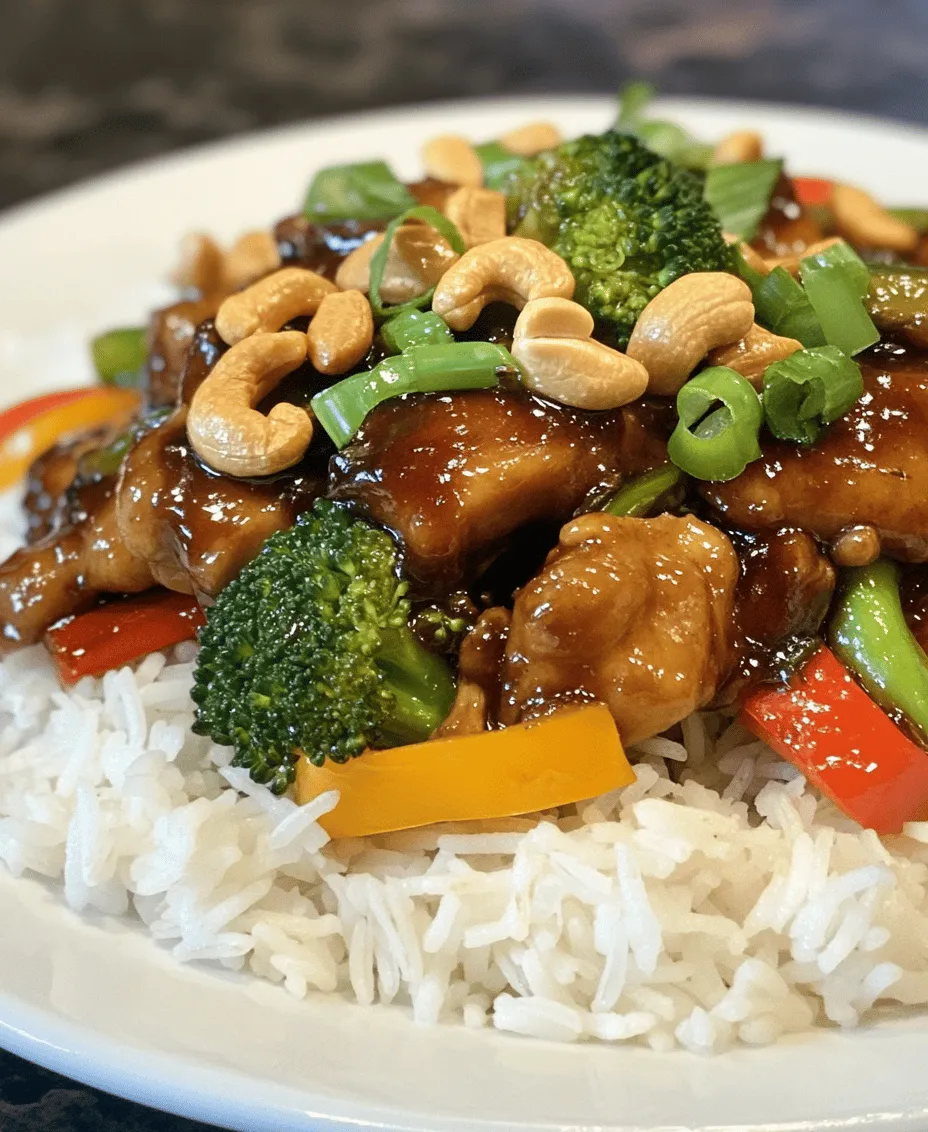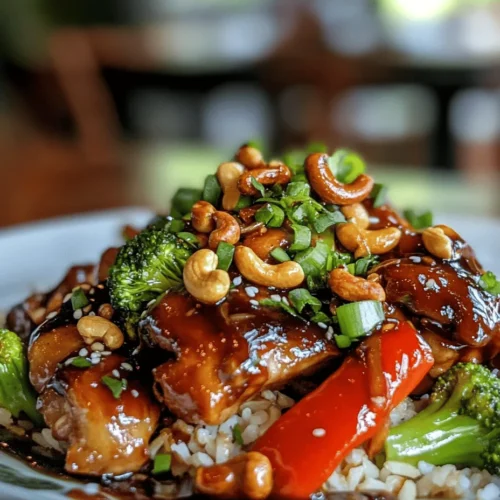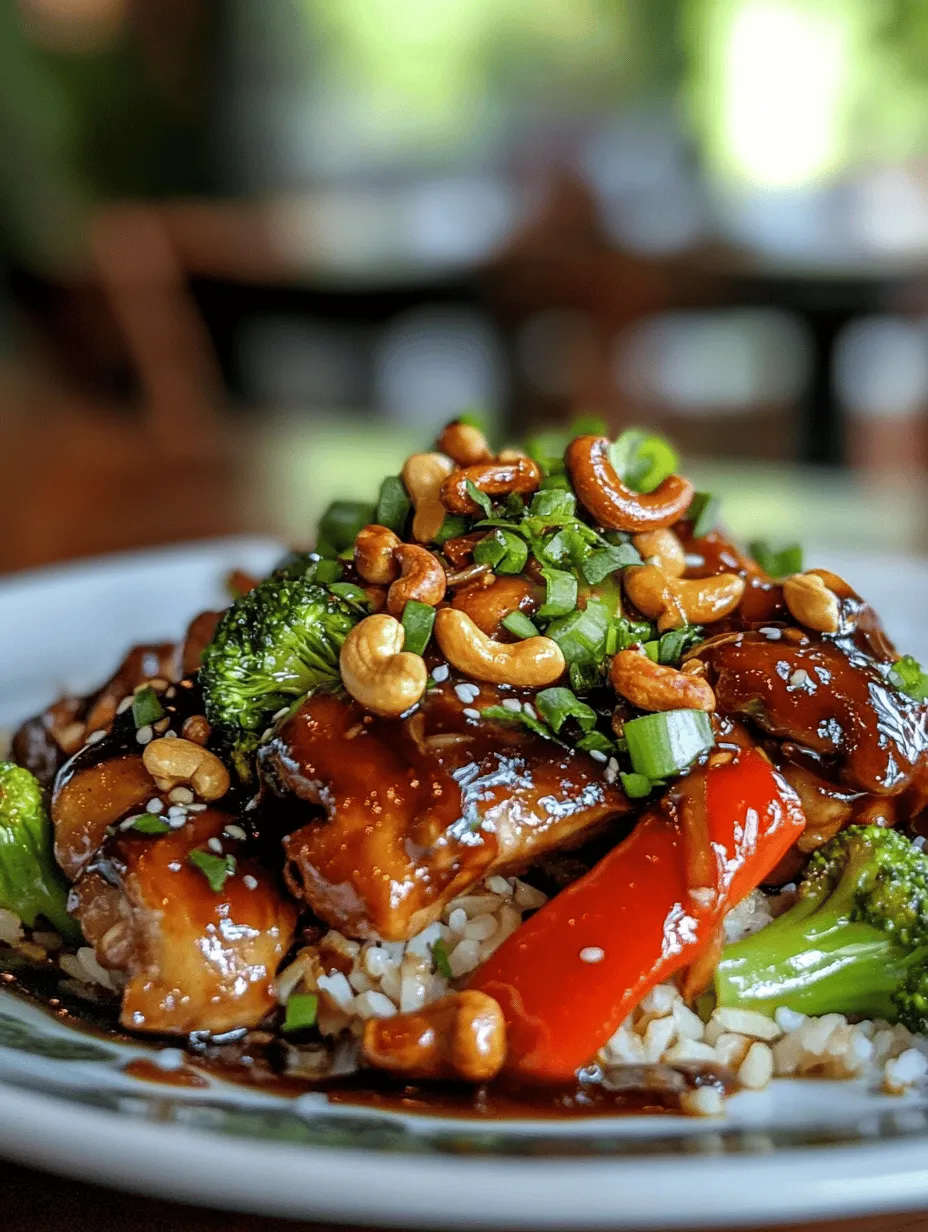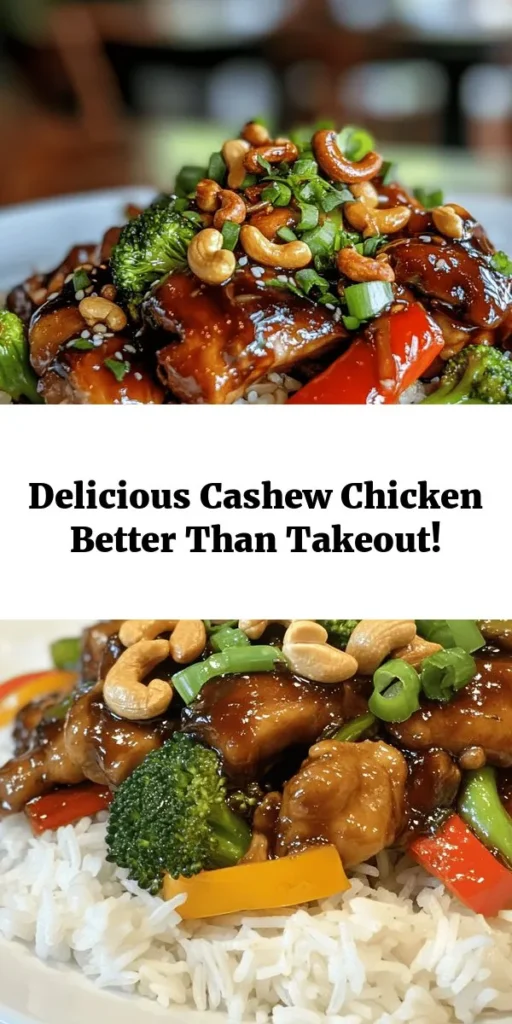Introduction
Explore the vibrant flavors and satisfying textures of Better-Than-Takeout Cashew Chicken, a delightful dish that brings the essence of Chinese cuisine right into your kitchen. This recipe not only rivals your favorite takeout order but also allows you to customize the ingredients according to your preferences. With tender chicken, crunchy vegetables, and a savory sauce, this meal is a perfect weeknight dinner that the whole family will love. In this article, we will delve into the ingredients, preparation, and cooking techniques that make this dish stand out, along with insights on its nutritional benefits and serving suggestions.
Understanding the Dish: What Makes Cashew Chicken Special?
Exploring the Origins of Cashew Chicken
Cashew Chicken has a rich history that reflects the broader narrative of Chinese-American cuisine. While the dish has its roots in traditional Chinese cooking, it has been adapted and transformed to suit American tastes since its introduction in the mid-20th century. Traditionally, cashew chicken is believed to have originated from the southern region of China, where cashews are commonly used in cooking. The dish became particularly popular in the United States, especially in the Midwest, where it was embraced for its unique combination of flavors and textures.
The appeal of combining cashews with chicken lies in the contrast they provide. The tender, juicy chicken is complemented by the crunchy, slightly sweet cashews, creating a delightful mouthfeel that makes each bite a rewarding experience. This dish not only showcases these ingredients harmoniously but also emphasizes the importance of balance in flavor, which is a key characteristic of well-executed Chinese cuisine.
Highlighting Key Ingredients
One of the standout features of Better-Than-Takeout Cashew Chicken is its use of fresh, high-quality ingredients. The role of chicken thighs in achieving tenderness cannot be overstated. Unlike chicken breasts, which can easily dry out if overcooked, chicken thighs contain more fat, making them juicier and more flavorful. Their rich taste pairs beautifully with the savory sauce and crunchy vegetables, providing a satisfying base for the dish.
Speaking of vegetables, the inclusion of fresh bell peppers and broccoli not only adds vibrant colors but also enhances the dish’s nutritional profile. Bell peppers are rich in vitamins A and C, while broccoli is a powerhouse of fiber and antioxidants. Together, they contribute to a well-rounded meal that is as nutritious as it is delicious. Additionally, the importance of aromatics like garlic and ginger in Asian cooking cannot be overlooked. These ingredients not only add depth of flavor but also offer numerous health benefits, including anti-inflammatory properties.
Finally, the sauce plays a crucial role in flavor development. A well-balanced sauce brings the entire dish together, creating a harmonious blend of sweet, salty, and umami flavors that is characteristic of Chinese cooking. Whether you prefer a more intense flavor profile or a milder taste, the sauce can be adjusted to suit your palate, making this dish highly customizable.
Ingredient Breakdown: The Essentials for Better-Than-Takeout Cashew Chicken
Chicken: Choosing the Right Cut
When it comes to making the best cashew chicken, the choice of chicken cut can significantly impact the final result. Boneless, skinless chicken thighs are the preferred choice for several reasons. First, they cook quickly and remain moist, ensuring that you achieve that tender texture that is essential for this dish. Additionally, thighs are often more economical than chicken breasts, making them a smart choice for budget-conscious cooks.
If you have dietary preferences or restrictions, there are alternatives to consider. For instance, you can use skinless chicken breasts if you prefer leaner meat, though you may need to be cautious about not overcooking them to retain moisture. Alternatively, for a plant-based option, cubed tofu or tempeh can be used, offering a similar texture when sautéed properly.
Fresh Vegetables for Flavor and Texture
Selecting the best vegetables is key to elevating your cashew chicken. Bell peppers, in particular, are a fantastic addition, as they offer a sweet crunch that complements the savory elements of the dish. When choosing bell peppers, look for vibrant colors—red, yellow, or orange—as they tend to be sweeter than green peppers. Aim for firm peppers with smooth skin, and avoid any that show signs of wrinkling or blemishes.
Broccoli is another essential component, adding not just flavor but also a satisfying crunch. Fresh broccoli florets can be quickly blanched or steamed to retain their bright green color and crisp texture, enhancing the visual appeal of your dish.
Don’t forget the importance of aromatics like garlic and ginger. Freshly minced garlic adds a pungent kick, while ginger provides warmth and a slightly spicy undertone. These ingredients are staples in Asian cuisine and contribute significantly to the overall flavor profile.
Sauce Components: Balancing Flavor
The sauce is where the magic happens in Better-Than-Takeout Cashew Chicken. A good sauce should strike a balance of flavors—sweet, salty, and umami—to create a cohesive dish. The primary components of the sauce typically include soy sauce, oyster sauce, and hoisin sauce.
Soy Sauce: This fermented sauce is a staple in many Asian dishes, providing saltiness and depth of flavor. For a gluten-free option, look for tamari or coconut aminos.
Oyster Sauce: Often overlooked, oyster sauce adds a rich, slightly sweet flavor that enhances the overall taste of the dish. It’s made from cooked oysters, but there are vegetarian versions available that use mushrooms instead.
Hoisin Sauce: This thick, sweet sauce brings a unique flavor to the mix, with hints of garlic and spices. It is essential for achieving that signature taste found in many Chinese takeout dishes.
To achieve the perfect consistency for your sauce, cornstarch plays a vital role as a thickening agent. When mixed with water and added to the sauce, it creates a glossy finish that clings to the chicken and vegetables, enhancing both the appearance and mouthfeel of the dish.
Preparation Steps: Creating the Perfect Cashew Chicken
Prepping the Chicken for Maximum Flavor
Before diving into cooking, preparing the chicken properly is crucial for ensuring maximum flavor. Start by cutting the boneless, skinless chicken thighs into bite-sized pieces. This not only helps them cook evenly but also allows for better absorption of the flavors in the marinade and sauce.
One effective technique is to coat the chicken pieces with a light dusting of cornstarch. This step not only adds a bit of crunch but also helps to lock in the juices, preventing the chicken from becoming dry during cooking. To do this, place the chicken in a bowl, sprinkle with cornstarch, and toss until evenly coated. You can also season the chicken with a pinch of salt and pepper at this stage for an extra layer of flavor.
Crafting the Sauce: A Simple Yet Flavorful Mix
Creating the sauce for your Better-Than-Takeout Cashew Chicken is a straightforward process that can be done in just a few minutes. Start by gathering your sauce ingredients: soy sauce, oyster sauce, hoisin sauce, and cornstarch mixed with a bit of water to form a slurry.
In a small mixing bowl, combine the soy sauce, oyster sauce, and hoisin sauce. Whisk together until well blended. This mixture forms the base of your sauce, bringing together the essential flavors that will coat the chicken and vegetables.
Next, add the cornstarch slurry to the sauce mixture. This will ensure that your sauce thickens properly during cooking, providing that desirable glossy finish. Mix well until the cornstarch is fully incorporated, and set the sauce aside while you prepare to cook the chicken and vegetables.
By following these steps, you are well on your way to creating a delicious Better-Than-Takeout Cashew Chicken that will impress your family and friends. The combination of tender chicken, crunchy cashews, and vibrant vegetables in a flavorful sauce is sure to satisfy your cravings for takeout while allowing you to enjoy the benefits of homemade cooking.

How to Adjust the Sauce for Different Flavor Profiles
One of the best aspects of our Better-Than-Takeout Cashew Chicken is the adaptability of the sauce. Depending on your taste preferences, you can easily adjust the flavors to create a dish that suits your palate. Here are some variations you might consider:
– Sweet and Savory: If you prefer a sweeter sauce, add a tablespoon of honey or brown sugar. This will enhance the natural sweetness of the bell peppers while balancing the saltiness of soy sauce.
– Spicy Kick: For those who enjoy a bit of heat, incorporate some red pepper flakes or a teaspoon of sriracha into your sauce. This addition will bring a delightful warmth to the dish without overpowering the other flavors.
– Tangy Twist: A splash of rice vinegar or fresh lime juice can be added for a tangy flavor. This acidity will brighten the dish and enhance the overall flavor profile.
– Umami Boost: For an extra depth of flavor, consider adding a spoonful of oyster sauce or hoisin sauce. These ingredients can elevate the umami notes and make the dish even more savory.
Cooking Techniques for Perfect Chicken and Vegetables
Best Practices for Stir-Frying in a Skillet or Wok
The stir-frying technique is essential in creating a dish that is both flavorful and visually appealing. Here are some key tips to maximize the effectiveness of your stir-fry:
1. Preheat Your Pan: Always preheat your skillet or wok before adding oil. This ensures that the chicken sears quickly, locking in moisture and flavor.
2. Use the Right Oil: Choose oils with a high smoke point, such as vegetable oil, canola oil, or peanut oil. These oils can withstand high heat without burning, ensuring a perfect stir-fry.
3. Small Batches: Avoid overcrowding the pan. Cooking the chicken and vegetables in small batches allows for even cooking and prevents steaming, which can result in a soggy texture.
Timing for Cooking Chicken and Vegetables to Retain Texture
Timing is crucial in stir-frying to achieve the perfect texture. Here’s a simple breakdown:
– Chicken: Cook the chicken for about 4-5 minutes, or until it is browned and cooked through. Remove it from the pan and set it aside before cooking the vegetables.
– Vegetables: Stir-fry the vegetables for 2-4 minutes. Aim for vibrant colors and a slight crunch. They should be tender but not mushy. Broccoli, bell peppers, and snap peas are great choices as they maintain their structure when cooked quickly.
Cooking Process: Step-by-Step to Success
Detailed Cooking Instructions
1. Prepare Your Ingredients: Start by chopping all your vegetables and marinating the chicken in a mixture of soy sauce, cornstarch, and a dash of sesame oil for about 15-20 minutes. This will enhance the flavor and tenderize the meat.
2. Heat the Oil: In a large skillet or wok, heat about 2 tablespoons of oil over medium-high heat.
3. Cook the Chicken in Batches: Add the chicken to the pan in a single layer. Allow it to sear without moving it for 2-3 minutes. Once browned, flip it over and cook for an additional 2 minutes. Remove the chicken from the pan and set it aside.
4. Stir-Fry the Vegetables: In the same pan, add a little more oil if necessary, then toss in your chopped vegetables. Stir-fry for 2-3 minutes until they are just tender but still crisp.
5. Combine Ingredients for a Flavorful Finish: Return the chicken to the pan and pour in your prepared sauce. Stir everything together, ensuring the chicken and vegetables are well coated. Cook for an additional 2-3 minutes, allowing the sauce to thicken slightly.
6. Final Touch: Add the cashews and sliced green onions. Stir to combine and remove from heat.
Serving Suggestions: Pairing Cashew Chicken with the Perfect Sides
Choosing the Right Accompaniment
To complement your Better-Than-Takeout Cashew Chicken, consider the following side dishes:
– Jasmine Rice: This fragrant rice is a classic pairing with Asian dishes. Its subtle aroma and fluffy texture soak up the delicious sauce perfectly.
– Alternative Sides: For a healthier option, you can serve the cashew chicken over quinoa, which adds additional protein and fiber. Alternatively, stir-fried noodles or whole wheat noodles can also be a satisfying base for the dish.
Presentation Tips for a Restaurant-Quality Look
1. Arranging the Dish: Serve the cashew chicken over a mound of jasmine rice or quinoa. Arrange the chicken and vegetables neatly on top for an enticing presentation.
2. Garnishing Ideas: Add a sprinkle of sesame seeds or freshly chopped cilantro on top for a pop of color and flavor. A few lime wedges on the side not only look appealing but also provide a fresh squeeze of acidity when served.
Nutritional Benefits of Cashew Chicken
Analyzing the Nutritional Value
One of the highlights of this Better-Than-Takeout Cashew Chicken is its nutritional profile. Here’s a breakdown:
– Calories: A typical serving contains approximately 300-400 calories, depending on the portion size and added ingredients.
– Proteins and Fats: The chicken provides a good source of lean protein, while cashews add healthy fats, including omega-3 and omega-6 fatty acids, which are essential for heart health.
– Vitamins and Minerals: The colorful vegetables contribute essential vitamins, such as vitamin C from bell peppers and fiber from broccoli, promoting digestive health.
Balancing Your Meal
This dish fits well into a balanced diet. To enhance its nutritional value:
– Incorporate More Vegetables: Consider adding a variety of vegetables like carrots, bok choy, or mushrooms for additional nutrients and flavors.
– Portion Control: Be mindful of portion sizes, especially with rice or noodles. Aim for a balance of protein, healthy fats, and carbohydrates to keep your meal nutritious.
Conclusion
Better-Than-Takeout Cashew Chicken is not only a delicious alternative to your favorite takeout but also a nutritious and satisfying meal that can be prepared in just 30 minutes. With its blend of tender chicken, colorful vegetables, and a flavorful sauce, this dish is sure to become a staple in your home cooking repertoire. By following the preparation and cooking techniques outlined in this article, you can enjoy a restaurant-quality meal that is both easy and rewarding. Embrace the joys of cooking and savor the delightful flavors of this homemade dish that rivals any takeout experience.



